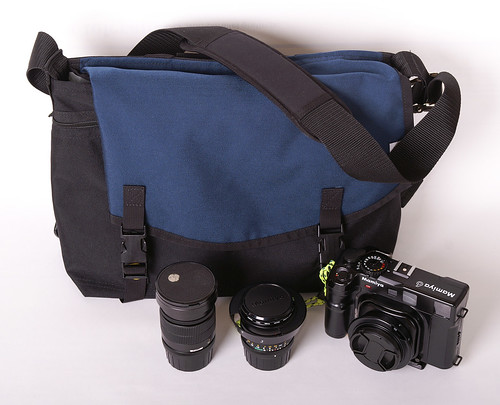Bill: I sill get a good laugh each time I remember your column on the Digital Journalist in which you wrote of being a recovering bag addict. That's a classic.
For my part, I learned long ago to use only light-weight working bags. I once bought a fancy new bag in the days of heavy leather shoulder bags and immediately took it out on a job. I was shooting a political convention in fairly low light. When I enlarged the negs, I discovered to my great dismay that many were very soft, despite my having stayed well within my usual hand-held shutter speeds. The problem, it turned out, was that when I moved too quickly to frame a shot the heavy bag hanging from my shoulder would swing like a pendulum and cause my whole upper body to move, too. I immediately returned to using my light-weight canvas fishing bag, and the new one was relegated forever after to storage.
Today my basic problem with bags is that I want one bag that satisfies at least two different roles: transport and working. I now shoot mostly street photos and documentation, and I usually don't need to do any post-processing while traveling. I like to travel with a small backpack for a few changes of clothes, etc. and have a another very small bag for my photo gear. That way I can easily carry everything onto a plane, train or bus and can zip through customs at national borders; when working, the gear bag will be small, versatile and relatively inconspicuous. I don't want to leave gear in my lodgings while I'm out, so I limit myself to what I think I will actually use, rather than to take everything I could imagine using. To further help my situation, I carry chargers and less frequently used accessories in my backpack rather than in the photo bag.
When near home, I use a very old bag from Eagle Creek. It wasn't designed as a camera bag, but it will hold an M8 body, three or four lenses, a spare battery, a small notebook and pencil and a mobile phone. For transport, it's a tight fit with all the gear, but when working, the M8 is in my hand or on a strap, so a little re-arranging turns it into a good working bag. Another attribute of the bag is that it has both a detachable shouler strap and a waist belt. Either can be stowed in a small, thin pocket in the bag when not in use. This flexibility gives me the best of both worlds, and the construction of this bag is light enough so that it wraps nicely around my body while hanging stably from the shoulder strap. A most important attribute for working out of this bag is that it has a single zipper across the top that provides simple access to the lenses inside. I leave the zipper open while I'm working and can easily grab and change lenses.
When traveling further afield, I feel compelled to take a second M8 body and four or five lenses, and these will not all fit in the Eagle Creek. It's here that I have an unresolved need: a bigger Eagle Creek - which I have not yet found. Last fall I took a "Photo Runner" from Lowe on a five-week trip. It's just enough larger than the Eagle Creek to carry the two M8s with four lenses, etc. It also has both a shoulder strap and a waist belt with a stowing pocket, but I found that it has two serious deficiencies. First, it is overly-padded. This makes it stiff, so it doesn't wrap nicely around my body and doesn't hang very well. I regard cameras as tools rather than collectable artifacts, and I don't require super-padding, since I'm quite willing to let my tools collect cosmetic dents, dings and wear. I do, however, like light-weight internal dividers which the old fishing bags didn't have. Second, this bag has a pair of zippers, one along each side of a long, wide flap which covers the top of the bag. I found this to be a problem. I can't work with just one zipper always open, because the stiff super-padding in the flap makes it difficult to reach through the open zipper. Nor can I work with both zippers open, because I found that I can't readily get at the lenses inside without leaving this stiff flap projecting out in space where it can restrict my motion, hang up on nearby objects or get bumped by people in a crowd.
Most of the alternative bags that I've seen or found mentioned, here and elsewhere, would appear to be bigger and more conspicuous than what I want, especially since most are much deeper than is needed for rangefinder equipment, because they were designed to carry DSLRs and their big autofocus lenses. Many also have a "flap problem" that seems even worse than the Photo Runner's. Like my old fishing bag, many alternate bags have very large flaps that cover both the top and front of the bag. The only obvious way to work with such a large flap would be to open it and then fold it back between bag and body. But thick or stiff flaps would prevent the bag from conforming and hanging well.
So, as you can see, I'm still picking nits with bags and am still looking for MY perfect bag ... which is almost certain to be different from YOUR perfect bag.
--- Mike






